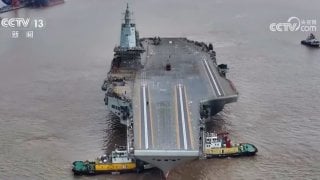China's Aircraft Carrier Nightmare Is Just Getting Started
China's pursuit of aircraft carriers alongside its anti-access/area denial (A2/AD) strategy presents a strategic opportunity for the United States and its allies in Asia. While China aims to nullify US naval power, an alliance of regional powers could counterbalance this by replicating China's A2/AD tactics.
Summary: China's pursuit of aircraft carriers alongside its anti-access/area denial (A2/AD) strategy presents a strategic opportunity for the United States and its allies in Asia. While China aims to nullify US naval power, an alliance of regional powers could counterbalance this by replicating China's A2/AD tactics. With a network of counter-A2/AD capabilities and collaboration among US allies, including Japan, India, and others, China's carrier fleet could be neutralized. This coalition could level the playing field, nullifying China's maritime advantage and ensuring stability in the Indo-Pacific.
The Strategic Paradox: China's Aircraft Carriers vs. A2/AD Coalition
China is intent on building its own aircraft carriers, which is a strange circumstance, since Beijing has spent so much time and money building a comprehensive anti-access/area denial (A2/AD) network designed to negate whatever advantages America’s fleet of aircraft carriers confer upon the United States Navy.
The rise of China’s carriers, though, could present a pristine opportunity for the United States—and, more importantly, its regional allies—to hold China’s navy hostage the way that Beijing intends to hold America’s navy hostage, in the event of a war between the two sides (which is likely coming soon).
While China believes that their A2/AD systems, which can create what they refer to as defensive “bubbles” around regions they don’t want the US Navy (or Air Force) operating in, such as the Taiwan Strait or the South China Sea, Beijing assumed that their navy will be able to operate with impunity.
According to these thinkers, the only stumbling block to Chinese plans for these regions is not their Asian neighbors, such as Taiwan or Japan or Vietnam or the Philippines.
It is, instead, the power of the United States Navy.
The Importance of the US Navy in Asia
The US Navy is the lynchpin for the resistance to China’s aggression. China assumes that denying the US Navy access to their part of the world will be enough to allow for China to run roughshod over the Asian territories they covet.
Indeed, Chinese scholars often point to the long history of China as an imperial power. For most of China’s history, the other nations of Asia have either kowtowed Chinese rulers or have simply isolated away from China and remained inward-looking (until China was overrun by the West after the fourteenth century).
But the Americans can—and should—disabuse Beijing of its erroneous assumptions.
America Should Replicate China’s A2/AD Approach in Asia
Sure, with A2/AD, China might be able to deprive the US of key power projection capabilities. Yet, the Americans (and their regional allies) must build their own network of counter-A2/AD capabilities. The Chinese, for example, have spent more than a decade building illegal, manmade islands throughout the South China Sea.
These manmade islands not only have the ability to harry international shipping passing through that important and crowded region but they also bring Chinese A2/AD capabilities much farther from their shores—giving these systems even greater range than they already have.
With nations like Japan, the Philippines, Vietnam, Taiwan, South Korea, and even India ringing China, America and its allies could do the exact same thing to China’s navy that Beijing plans to do to America’s navy.
The Western allies in the Indo-Pacific could prevent China’s growing aircraft carrier fleet from being much of a threat to the US and its allies in the Indo-Pacific. In fact, sophisticated A2/AD capabilities arrayed against China could further negate China’s surface fleet from safely deploying against US allies in the region.
After A2/AD, Hypersonic Weapons and Drones
This, then, would leave only longer-range weapons platforms as well as unmanned weapons systems as the only real threats. In this scenario, rather than China enjoying an asymmetrical advantage over the Americans, the two sides would be evenly matched.
Sure, China has ample advantages in the hypersonic weapons domain.
But the Americans are catching up. What’s more, both Japan and India have made stunning advances in this critical area. If they were brought together in this A2/AD coalition against China, these regional US allies could savage China’s forces.
Nullifying China’s Carrier Challenge
China has a paradoxical strategy.
On the one hand, they rightly understand that if their forces can negate the ability of the US Navy to deploy key strategic assets, like the aircraft carrier, into the Indo-Pacific during a crisis, then the Chinese military will have a real advantage over the Americans.
At the same time that China is preparing to nullify the US carrier threat to their forces with A2/AD, the Chinese are expanding their own carrier fleet. By bringing Japan, India, South Korea, the Philippines, Vietnam, and Taiwan together—along with US assets in the region—into a comprehensive, layered A2/AD alliance, the Western forces could destroy China’s ambitious offensive plans.
And once China’s surface fleet was stymied as badly as Beijing plans on stymying the American fleet, the combined forces of the American-led Asian allies could use overwhelming force to stunt whatever aggression China is planning to engage in throughout their region, forcing China to stand down, and saving US power in the region.
About the Author
Brandon J. Weichert is a former Congressional staffer and geopolitical analyst who is a contributor at The Washington Times, as well as at American Greatness and the Asia Times. He is the author of Winning Space: How America Remains a Superpower (Republic Book Publishers), Biohacked: China’s Race to Control Life, and The Shadow War: Iran’s Quest for Supremacy. Weichert can be followed via Twitter @WeTheBrandon.


